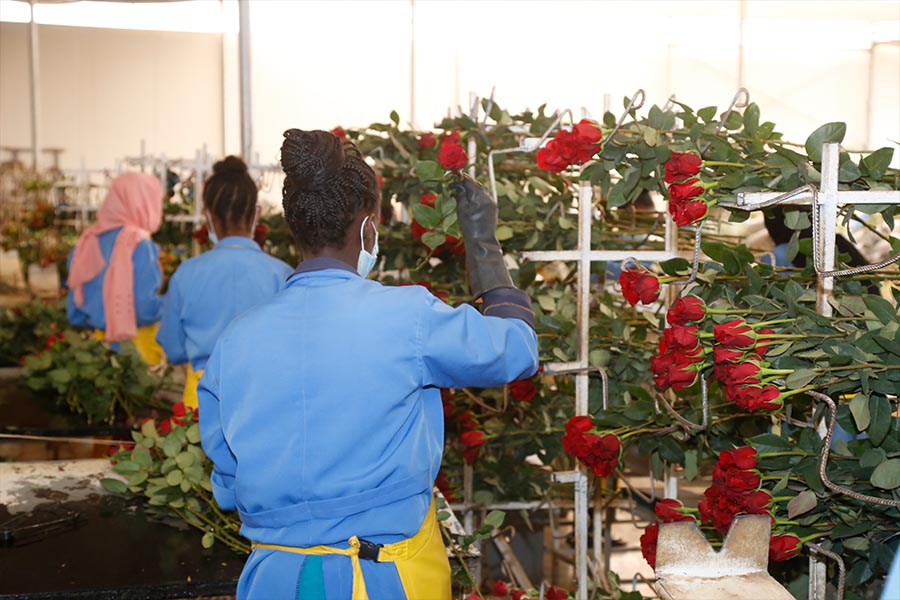
The recent directive from the National Bank of Ethiopia (NBE) mandating that exporters convert half their foreign exchange earnings into Birr within a month has triggered discontent within the flower industry and broader horticulture sector.
The regulation, part of a sweeping overhaul of foreign exchange rules effective July 29, 2024, is seen by many in the industry as an impediment, given the logistical complexities and extended timelines involved in importing essential inputs. Exporters are particularly distressed by the tight timeframe, which they argue is incompatible with the realities of their business operations. According to Tewodros Zewdie, president of the Ethiopian Horticulture Producers & Exporters Association (EHPEA), the 30-day limit is insufficient, especially for businesses dealing with extended import processes. “The time is not enough,” he said.
The Association represents 126 members, all of whom are wrestling with the directive’s implications on their ability to maintain a steady flow of imports, crucial for sustaining their operations. Despite acknowledging the directive’s potential benefits, such as improved revenue optimisation and access to investment financing, Tewodros expressed hope that ongoing discussions with NBE officials would lead to a revision of the policy. He stressed the importance of these engagements, noting that they cover various export sectors, including oilseeds, pulses, coffee, and horticulture. “We’re hopeful it will be addressed soon,” he told Fortune.
Central bank officials defend the directive, arguing that it ensures idle foreign currency earnings are surrendered to commercial banks within a month, injecting much-needed liquidity into the forex market. Abebayehu Dufera, NBE’s deputy director of foreign currency monitoring and reserve management, acknowledged the exporters’ concerns as valid but disclosed that the measure is temporary. The directive is intended to control export revenues and strengthen the interbank foreign exchange market. “It’ll only stay in effect until there is enough inflow into the banks,” he told Fortune.
Yirga Tesfaye, an economic researcher, praised the central bank’s strategy, which cautiously liberalises foreign currency retentions for exporters while managing foreign currency risks. “It’s a wise move,” he said.
However, Yirga warned that exporters face a consequential market shock in the new, volatile domestic market. He argued that building hedging and derivative strategies addresses risks and reduces the impact of exchange rate fluctuations on earnings. “Business is not as usual for exporters anymore,” he told Fortune.
The central bank recently launched a “special foreign exchange auction,” attaining price discovery at a weighted average rate of 107.9 Br for a dollar. Officials are optimistic that this trend will continue, supporting import activities and enhancing foreign exchange liquidity.
orqu Lemma, a senior banker, attributed the foreign currency crunch faced by most commercial banks to the retention limit. He believes that more dollars within the system will grant liquidity to commercial banks, contribute to price stability, and improve foreign exchange access for other importers. “The forex revenue cannot stick in one place,” he said.
However, Worqu conceded that the time limit is unrealistic for businesses that require extended periods to complete imports. He acknowledged the liquidity issues facing commercial banks, partly due to the bonds they are required to purchase.
A business lobby, the European Chamber of Commerce in Ethiopia, also raised issues last week, pointing out drawbacks in the new directive that its leaders fear stifles business operations and investment. The EU Chamber has commended the federal government for introducing a market-based exchange rate as part of the new macroeconomic reform. However, its leaders also called for pending issues that have been overlooked, noting that while the reform may improve transparency and predictability for businesses and increase forex availability for manufacturers, long-standing macroeconomic imbalances have caused financial struggles for exporting manufacturers. Some have been forced to sell at a loss to sustain their import businesses, while others have compensated for losses by selling imported goods at high margins.
According to Bahiru Temesgen, director general of the Chamber representing 180 businesses, delays during imports could impede timely operations. He cited challenges such as freight issues, the security crisis on the Red Sea corridor, and payment delays in international transactions. “It’ll be burdensome for the exporters,” he said.
One exporter particularly affected by the directive is Joytech Plc, which operates a 100hct farm in Bishoftu (Debre Zeit), in Oromia Regional State. Its General Manager, Bisrat Haileselassie, disclosed that the company has suspended importing materials due to the risks involved, stating that the import process can take up to 60 days. “It’ll be impossible to import this way,” he told Fortune.
VegCrop Plc, a Kenyan-owned flower company operating in Ethiopia for over 12 years, has encountered difficulties due to the new forex rule. According to Mehandira Patel, its general manager, the time required for imports, from proforma invoices to the arrival of goods, can take up to two months. He criticised the absence of one-stop windows for different institutions, such as NBE and the Ministry of Agriculture, as well as the long bureaucratic processes that unnecessarily extend the timeline. The bureaucratic and logistical issues caused problems for the company, which imports fertilisers, chemicals, and packaging materials. The problems facing Ethiopia’s horticulture industry are particularly acute this year.
Despite its promising potential, horticulture exports have seen an alarming 22pc decline, dropping to 535 million dollars, the first drop in over a decade. Flowers continue to claim a substantial share of export proceeds, accounting for 86pc of the nearly four billion dollars earned last fiscal year, while vegetables and fruits lag. The Ministry of Agriculture has introduced a 10-year strategy to promote the sector, appropriating 24.5 billion dollars in investment over the next decade. The strategy sets ambitious goals, including increasing the horticulture sector’s contribution to GDP to 12pc, from the current 4.5pc, and reducing post-harvest losses to 20pc.
Source: ehpea.org
